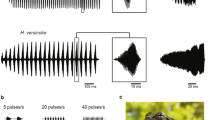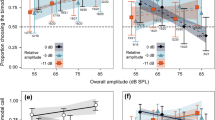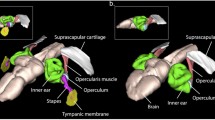Summary
-
1.
Eleutherodactylus coqui treefrogs spontaneously produce advertisement calls. Intercall intervals are typically between 2 and 3 s.
-
2.
When periodic tone burst stimuli were broadcast to individual frogs in the wild, their calling became entrained such that each vocalization occurred in the silent interval between stimulus tones.
-
3.
For stimulus repetition periods similar to the nominal call repetition period (2.5 s), the mode of the distribution of intercall intervals (preferred interval) matched the interstimulus interval (1∶1 locking or entrainment). The preferred interval continued to match the interstimulus interval when the latter was varied over a range of approximately 1 s, or 40% of the nominal spontaneous intercall interval. Faster stimulus rates (shorter interstimulus intervals) resulted in 1∶2 locking, in which calls were produced for every second tone burst.
-
4.
For each frog, the transition between 1∶1 and 1∶2 locking appeared to positively co-vary with the spontaneous preferred interval.
-
5.
The frogs were able to track a pseudorandom sequence of long and short duration tones. Long duration tones tended to be spanned by long intercall intervals while short duration tones were spanned with shorter intervals. Cueing to tone offset is the most parsimonious explanation for such tracking ability.
-
6.
These findings suggest that calling behavior inE. coqui is driven by an internal oscillator, the period of which may be adjusted over a considerable range in order to entrain to an external acoustic stimulus. Furthermore, the period of the oscillator may be changed within a single call cycle in response to a pseudorandom sequence of stimuli.
Similar content being viewed by others
Abbreviations
- i.p.s.p. :
-
inhibitory post synaptic potential
- PST :
-
post stimulus time
- FM:
-
frequency modulation
References
Alexander RD (1967) Acoustical communication in arthropods. Annu Rev Entomol 12:495–526
Awbrey FT (1978) Social interaction among chorusing Pacific tree frogs,Hyla regilla. Copeia 1978:208–214
Bagnoli P, Brunelli M, Magni F, Musameci D (1976) Neural mechanisms underlying spontaneous flashing and its modulation in the fireflyLuciola lusitanica. J Comp Physiol 108:133–156
Blair WF (1958) Mating call in the speciation of anuran amphibians. Am Nat 92:27–51
Cody ML, Brown JH (1969) Song asynchrony in neighboring bird species. Nature 222:778–780
Farabaugh SM (1982) The ecological and social significance of duetting. In: Kroodsma DE, Miller EH (eds) Acoustic communication in birds, vol 2. Academic Press, New York, p 85–124
Gerhardt HC (1978) Temperature coupling in the vocal communication system of the grey tree frog,Hyla versicolor. Science 199:992–994
Hanson FE, Case JF, Buck E, Buck J (1971) Synchrony and flash entrainment in a New Guinea firefly. Science 174:161–164
Heiligenberg W (1969) The effect of stimulus chirps on a cricket's chirping (Acheta domesticus). Z Vergl Physiol 65:70–97
Jansen JKS, Nja A, Walloe L (1970) Inhibitory control of the abdominal stretch receptor of the crayfish. I. The existence of a double inhibitory feedback. Acta Physiol Scand 80:420–425
Jones MDR (1966) The acoustic behaviour of the bush cricketPholidoptera griseoaptera 2. Interaction with artificial sound signals. J Exp Biol 45:31–44
Lemon RE (1971) Vocal communication by the frogEleutherodactylus martinicensis. Can J Zool 49:211–217
Lemon RE, Struger J (1980) Acoustic entrainment to randomly generated calls by the frog,Hyla crucifer. J Acoust Soc Am 67:2090–2095
Littlejohn MJ, Martin AA (1969) Acoustic interaction between two species of leptodactylid frogs. Anim Behav 17:785–891
Loftus-Hills JJ (1971) Neural correlates of acoustic behavior in the Australian bullfrogLimnodynastes dorsalis (Anura: Leptodactylidae). Z Vergl Physiol 74:140–152
Loftus-Hills JJ (1974) Analysis of an acoustic pacemaker in Strecker's chorus frog,Pseudacris strecken (Anura:Hylidae). J Comp Physiol 90:75–87
Mech LD (1970) The wolf: The ecology and behavior of an endangered species. Natural History Press, New York
Narins PM (1982) Behavioral refractory period in neotropical treefrogs. J Comp Physiol 148:337–344
Narins PM, Capranica RR (1976) Sexual differences in the auditory system of the tree frogEleutherodactylus coqui. Science 192:378–380
Narins PM, Capranica RR (1978) Communicative significance of the two-note call of the tree frogEleutherodactylus coqui. J Comp Physiol 127:1–9
Pavlidis T (1973) Biological oscillators: Their mathematical analysis. Academic Press, New York
Perkel DH, Schulman JH, Bullock TH, Moore GP, Segundo JP (1964) Pacemaker neurons: Effects of regularly spaced synaptic input. Science 145:61–63
Rosen M, Lemon RE (1974) The vocal behavior of spring peepers,Hyla crucifer. Copeia 1974:940–950
Schmidt RS (1973) Central mechanism of frog calling. Am Zool 13:1169–1177
Segundo JP (1979) Pacemaker synaptic interactions: Modelled locking and paradoxical features. Biol Cybern 38:55–62
Segundo JP, Kohn AF (1981) A model of excitatory synaptic interactions between pacemakers. Its reality, its generality, and the principles involved. Biol Cybern 40:113–126
Snow BW (1972) A field study of the calfbirdPerissocephalus tricolor. Ibis 114:137–162
Snow BW, Goodwin D (1974) The black-and-gold cotinga. Auk 91:360–369
Sokal RR, Rohlf FJ (1981) Biometry. Freeman, San Francisco, p 704
Thorpe WH (1972) Duetting and antiphonal song in birds: Its extent and significance. Behaviour [Suppl] 18:1–197
Wells KD (1977) The social behaviour of anuran amphibians. Anim Behav 25:666–693
Wells KD, Schwartz JJ (1984) Vocal communication in a neotropical treefrog,Hyla ebraccata: advertisement calls. Anim Behav 32:405–420
Zelick RD, Narins PM (1982) Analysis of acoustically evoked call suppression behaviour in a neotropical treefrog. Anim Behav 30:728–733
Zelick RD, Narins PM (1983) Intensity discrimination and the precision of call timing in two species of neotropical treefrogs. J Comp Physiol 153:403–412
Author information
Authors and Affiliations
Rights and permissions
About this article
Cite this article
Zelick, R., Narins, P.M. Characterization of the advertisement call oscillator in the frogEleutherodactylus coqui . J. Comp. Physiol. 156, 223–229 (1985). https://doi.org/10.1007/BF00610865
Accepted:
Issue Date:
DOI: https://doi.org/10.1007/BF00610865




